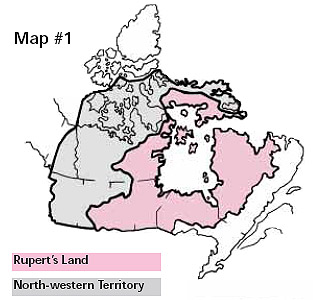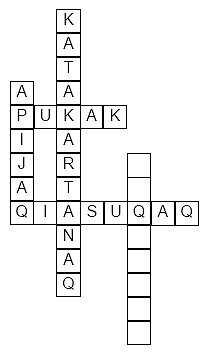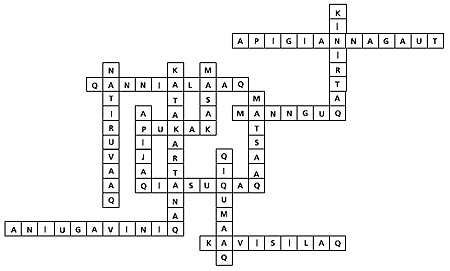Nunavut, Canada's Third Territory North of 60
On April 1, 1999, Canada created a third territory called Nunavut, which was carved out of the central and eastern area of the Northwest Territories (NWT). Inuit make up almost 85 percent of Nunavut's population. Nunavut means "our land" in Inuktitut, the Inuit language.
On this page
Nunavut
In the 1970s, Inuit began to organize in response to the fast-paced changes taking place in the north and affecting their lives. Some of the Inuit's concerns were about how oil, gas and mineral exploration in the north would affect them. They also feared that their cultural well-being, so strongly tied to the land, was at risk.
Inuit believe they must give equal respect to the spirits of the land, animals and plants. These beliefs guide Inuit in using the land, sea and other resources wisely. Inuit want to continue their traditional use of the land – hunting and trapping as their ancestors have done. In the face of resource exploration, Inuit are concerned about losing their traditional way of life.
In 1992, Inuit of the eastern Arctic began writing a new chapter in the story of Canada when they reached an agreement with the Government of Canada to create a new territory called Nunavut in 1999. Nunavut covers one-fifth of Canada – 2 million square kilometres, about three times the size of the island of Newfoundland – and is home to some 33,330 people, including 28,000 Inuit. It has 28 villages or communities, including the capital, Iqaluit, located on Baffin Island. That's where the territorial government is. About 7,250 people live in Iqaluit.
Inuit
For many years Inuit in Canada were called Eskimos. Today, these northern peoples are referred to as "Inuit," the Inuktitut word for "the people."
Today, most Inuit use snowmobiles instead of sleds and dog teams, live in houses instead of igloos and wear snowmobile boots and commercially made parkas. But some still follow traditional ways and wear traditional dress.
A favoured coat, for instance, is the amautik, a parka with an oversized hood. Women with young children like this coat because the large hood acts as a built-in baby pouch to carry their babies! Another favourite item is an ulu, a semi-circular knife that Inuit women have used for centuries and still use today to cut up seal meat. And while young children watch television, their grandmother chews a caribou skin to make it soft before turning the skin into moccasins.
Today's Inuit strive to transmit the heritage of their ancestors to their children. In school, children learn Inuktitut as well as English. Community Elders teach life skills courses to ensure that young Inuit learn about their culture. Students gain practical experience in such traditional skills as hunting, butchering and skinning of slain animals, and preparation of Inuit food.
Activities for grades 5-6
Activity #1
Inuit were very clever in making use of all their resources. Wood was so scarce, some Inuit used frozen fish wrapped in sealskin as dogsled runners. Talk about fish to go! Also, antlers, for instance, became fish hooks, and bones were turned into toys. But antlers and bones had other uses as well. Can you think of different ways to turn the animal parts listed below into clothes and tools? Be as creative as you can!
- antlers
- bird bones
- fur
- sealskin
- fat
- intestines (waterproof!)
- sinew (these are stringlike tendons that join bone to bone)
Activity #2
As you can see in Map #1, the current NWT was once a much larger territory known as Rupert's Land and the North-western Territory. Compare this map to Map #2, noting how the larger land was divided into provinces and territories.


Over time, the NWT was divided into other provinces and a territory: Manitoba in 1870, the Yukon Territory in 1898, and the provinces of Alberta and Saskatchewan in 1905. The boundaries of the NWT changed again in 1912, following the northward extension of Manitoba, Ontario and Quebec. Now that Nunavut has been created, the western territory is still known as the Northwest Territories.
Activity #3
During the winter, your local radio stations will broadcast snow conditions for your region or for local ski hills. Even if you're not a skier, you probably know what "fresh powder snow" looks and feels like. But just how frozen is a ski hill's "frozen granular base"?
In English, there are very few words for snow, but in Inuktitut there are at least 14 words! Do you think "frozen granular base" is aniugaviniq (very hard, compressed and frozen snow) or pukak (crystalline snow that breaks down and separates like salt)? Here are the 14 Inuktitut words for snow. How many conditions do you recognize? Try drawing a picture of these different types of snow!
- aniugaviniq
- very hard, compressed and frozen snow
- apijaq
- snow covered by bad weather
- apigiannagaut
- the first snowfall of autumn
- katakartanaq
- snow with a hard crust that gives way under footsteps
- kavisilaq
- snow roughened by rain or frost
- kinirtaq
- compact, damp snow
- mannguq
- melting snow
- masak
- wet, falling snow
- matsaaq
- half-melted snow
- natiruvaaq
- drifting snow
- pukak
- crystalline snow that breaks down and separates like salt
- qannialaaq
- light-falling snow
- qiasuqaq
- snow that has thawed and refrozen with an ice surface
- qiqumaaq
- snow whose surface has frozen after a light spring thaw.
Some of these words are already in the KrissKross puzzle. Can you add the right number of boxes and place the remaining words in them?
masak
pukak
6 letters
apijaq
7 letters
matsaaq
mannguq
8 letters
qiasuqaq
qiqumaaq
kinirtaq
kavisilaq
10 letters
qannialaaq
natiruvaaq
11 letters
aniugaviniq
12 letters
katakartanaq
13 letters
apigiannagaut

Activity #4 - Nunavut Fast Facts
- If Nunavut's area is 2 million square kilometres, and Canada's is 9,970,610 square kilometres, roughly what percentage of the land mass is Nunavut? (hint: divide 9,970,610 by 2 million)
- 28,000 Inuit live in Nunavut, out of a total population of 33,330. What percentage of the population is Inuit?
- What is the capital of Nunavut?
Answers to Activities for grades 5-6
Answer - Activity #1
Animal skins provided the basic materials to make tents and boats. Intestines were turned into waterproof jackets for kayakers. Caribou fur was used for parkas and pants, sealskin for boots.
Bird bones made excellent needles, and antlers became fish hooks or brakes for a dog sled. Sinew was used as thread. Animal fat was rendered into oil and used for heat and light.
Answer - Activity #3

Answer - Activity #4
- 20 percent or 1/5 of land mass
- 84 percent
- Iqaluit (pop. 7,250)